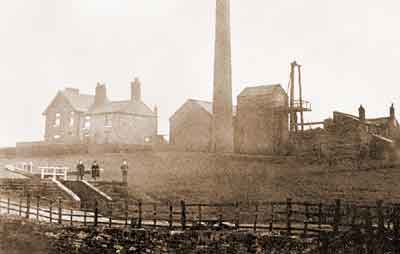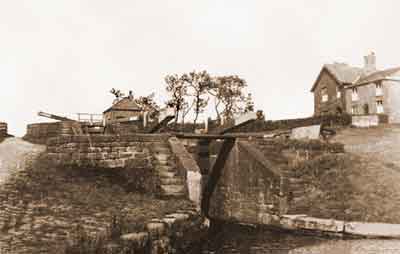
The Hollinwood Branch Canal left the mainline of the Ashton Canal at Fairfield Junction and it continued on the level for about 2¾ miles in a generally northerly direction to Waterhouses. Here it climbed the four Waterhouses locks (locks 19 - 22), the middle pair forming a staircase where the top gate of lock 20 was also the bottom gate of lock 21. Immediately above these locks, at Waterhouses Junction, the Fairbottom Branch left the Hollinwood Branch and this branch was about 1⅛-mile long. From Waterhouses Junction, the Hollinwood Branch continued for just over 2 miles and, after climbing through four more locks (locks 23 - 26), it terminated at Hollinwood Top Wharf to the north of Manchester Rd, Hollinwood.
The water supply to the summit pound of the Hollinwood Branch came from Hollinwood Reservoir which obtained its water from a stream. The capacity of this reservoir was about 12½ million gallons and it was situated on the east side of the canal between Manchester Rd and Chapel Rd. By canal standards, the capacity of this reservoir was inadequate. The summit pound was only about 130-yards long but at its head it made junction with the privately owned Werneth Branch. This would have acted as a reservoir for the Hollinwood Branch but it seems that this was insufficient. Nevertheless, it became disused shortly before 1876 (E Keaveney and D L Brown, 1974, p.23). It is understood that the Fairbottom Branch may also have acted as a feeder from the river Medlock (E Keaveney and D L Brown, 1974, p.23).
In 1812, owing to the heavy use of Waterhouses Locks and resulting loss of water, it was decided to save water by building a pump house containing a beam engine to power the pump. This was built on the south side of the Fairbottom Branch, straight opposite staircase locks 20 and 21 on the Hollinwood Branch. At this point the two branches are about 63-yards apart. The pump raised water from the bottom pound of the Hollinwood Branch to the top of the four Waterhouses Locks. Each time a boat passed through these locks about 35,000 gallons of water was used and the pump replaced this in about half an hour. The pump raised the water to a wooden trough that conveyed it across the pump-house yard and then discharged it into the Fairbottom Branch.
By the mid-1950s the disused pump house was in a poor state of repair but the beam engine and pump were still in a reasonable condition, having been regularly maintained by staff from the Gorton Canal Depot on the Stockport Branch of the Ashton Canal. Afterwards, intruders completely wrecked the pump house and machinery and in the early 1960s the machinery was removed for scrap and the pump house was demolished.
The beam engine in the pump house at Waterhouses should not be mistaken for the nearby 'Fairbottom Bobs' beam engine, which was saved and is now in the Henry Ford Museum at Dearborn, Michigan, USA. This was an early atmospheric engine of the Newcomen type, dating from about 1760, used to pump water out of a coal mine.
 |
 |
The lock cottages, left, and pump house, right, adjacent to Waterhouses Locks. In the left foreground is the lower of the two staircase locks (lock 20). The cottages were occupied by the staff who cared for the locks and pump house. |
The staircase locks (locks 20 & 21) at Waterhouses. A brick-built hut stands by the upper staircase lock (lock 21) and the lock cottages are in the background on the right. |